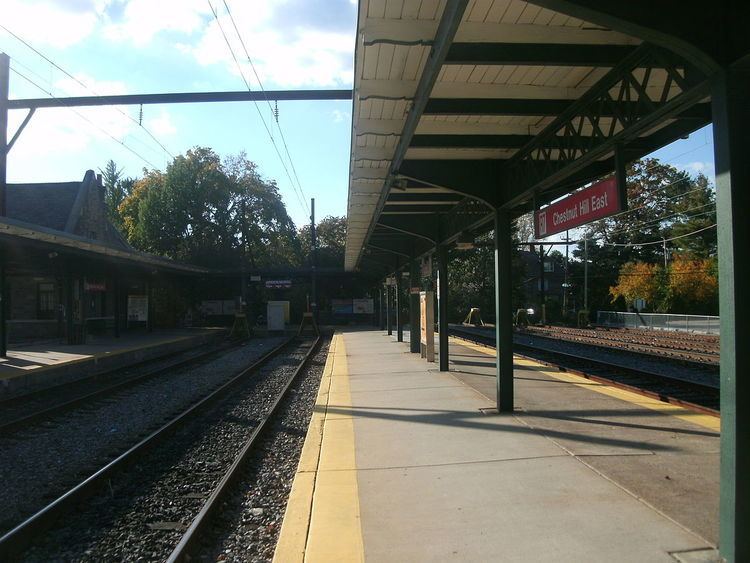Type Commuter rail line Status Operating Website septa.org | Daily ridership 5,768 Operator SEPTA | |
 | ||
Track gauge 4 ft 8 ⁄2 in (1,435 mm) standard gauge Terminis 30th Street Station, Chestnut Hill East station | ||
Train simulator 2016 septas chestnut hill east line
The Chestnut Hill East Line is a route of the SEPTA Regional Rail (commuter rail) system. The route serves the northwestern section of Philadelphia with service to Germantown, Mount Airy, and Chestnut Hill. It is one of two lines that serve Chestnut Hill, the other one being the Chestnut Hill West Line.
Contents
- Train simulator 2016 septas chestnut hill east line
- Septa chestnut hill east line 22nd jfk
- History
- Stations
- Ridership
- References
Septa chestnut hill east line 22nd jfk
History
The Chestnut Hill East Line uses the Reading Company right-of-way, which was originally constructed by the Philadelphia, Germantown, and Norristown (PG&N) railroad before the American Civil War. The PG&N intended to build a railroad from Philadelphia to Norristown but stopped when construction reached Germantown due to the hilly nature of the terrain west of Germantown and along the Wissahickon Creek, which they would have had to cross to reach Norristown. The PG&N decided to change course and build another railroad line close to the Schuylkill River. This line would become SEPTA's Manayunk/Norristown Line. The original railroad line that ended in Germantown was then extended north with a sharp right hand turn and then northwest to its present terminus in Chestnut Hill (where the Chestnut Hill West Line also has a terminus only a few hundred yards away).
The Chestnut Hill Railroad Company was incorporated in Pennsylvania on July 11, 1851 to own the railroad planned for Chestnut Hill. An eastern and western route were surveyed to Chestnut Hill in 1848 by William E. Morris, and the eastern route was chosen for the line. The railroad was opened to traffic on December 1, 1854. It was operated by the Philadelphia, Germantown and Norristown Railroad Company (PG&N) from December 1, 1854 until November 30, 1870, under a lease dated March 17, 1852. By agreement dated November 10, 1870, the lease was assigned by the PG&N to The Philadelphia & Reading Railroad Company. By indenture dated November 30, 1870, a new lease was made by the Chestnut Hill Railroad Company to The Philadelphia & Reading Railroad Company for 999 years from December 1, 1870. The obligation of The Philadelphia & Reading Railroad Company was assumed by the Philadelphia and Reading Railway Company on December 1, 1896, and the lease was amended in certain respects by Agreement dated January 27, 1897.
The line was elevated in 1930. Electrified service to Chestnut Hill (and to Norristown) was opened on February 5, 1933. By order dated March 23, 1940, in Finance Docket No. 12749, the Interstate Commerce Commission authorized Reading Company to acquire control of the Chestnut Hill Railroad Company by purchase of additional shares of capital stock. On December 31, 1948, the Chestnut Hill Railroad Company was merged into Reading Company. The line continued to be operated as part of the Reading Company's passenger lines up until April 1, 1976, when the Reading's passenger lines were conveyed to SEPTA as part of the company's bankruptcy reorganization.
Until 1984 Chestnut Hill East trains used the Reading Viaduct to reach Spring Garden Street and the Reading Terminal; this ended with the opening of the Center City Commuter Connection which routed the trains through the city center and on the ex-Pennsylvania Railroad part of the system. From this point the route was designated R7 Chestnut Hill East as part of SEPTA's diametrical reorganization of its lines; trains continued on to the Trenton Line. The R-number naming system was dropped on July 25, 2010.
Stations
The Chestnut Hill East makes the following station stops after leaving the Center City Commuter Connection; stations indicated with italics are closed. Weekday boardings are from FY 2013; data for Temple University and Wayne Junction include all lines serving those stations. All stations are located within Philadelphia.
Ridership
Yearly ridership on the Chestnut Hill East Line between FY 2008–FY 2014 has remained steady around 1.5–1.6 million, save for a dip in FY 2011:
